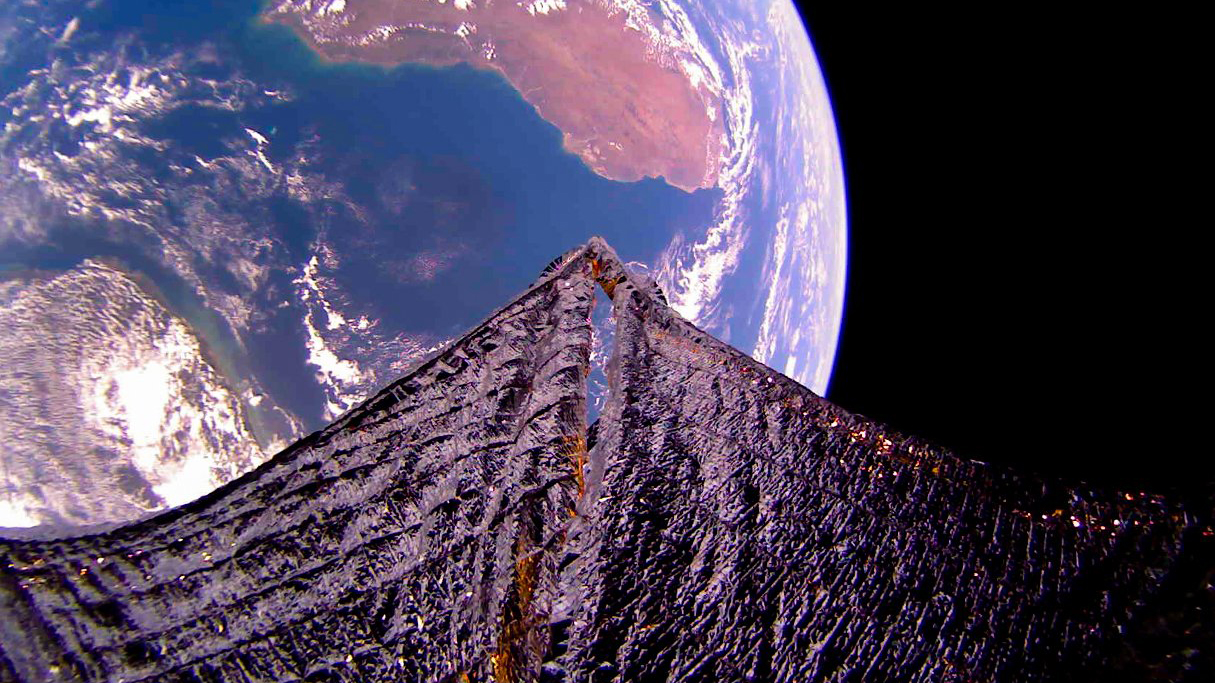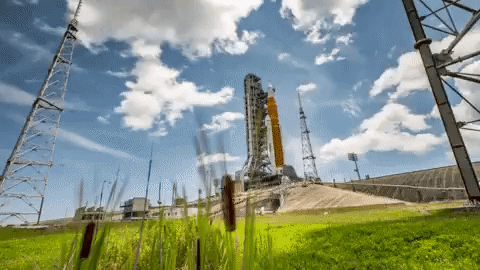June 2022
RocketLab's moonbound rocket leaves a stunning trail after launch

Thursday, June 30, 2022: RocketLab's Electron rocket lifted off from New Zealand's Māhia Peninsula on Tuesday (June 28) with a pioneering moon-bound satellite aboard, leaving a stunning trail in its wake.
The CAPSTONE mission, operated by NASA, is expected to reach the moon's orbit in November this year. The small satellite will test the stability of the orbit NASA plans to use for its Gateway lunar space station. The launch was RocketLab's first aiming for deep space. The company is known for launching small satellites into low Earth orbit. – Tereza Pultarova
The faintest ever asteroid observed by Very Large Telescope

Wednesday, June 29, 2022: The Very Large Telescope in Chile managed to track an extremely faint asteroid to help rule out its projected collision with Earth.
The asteroid, dubbed 2021 QM1, was discovered in August last year. Initial observations indicated it was bound to slam into our planet in 2052. The asteroid then disappeared for several months in the glare of the sun as it approached the star. When it reemerged in the darker sky again, it was too far away for most ground-based telescopes to see. But the European Southern Observatory's Very Large Telescope in Chile, one of the most powerful optical telescopes in the world, rose to the challenge and detected the asteroid when it had a magnitude of 27 (the sun, by far the brightest object in the sky, has a magnitude of minus 27). On top of that, astronomers had to find the super-faint space rock on the backdrop of the star-studded band of the Milky Way. The observations enabled astronomers to finetune the calculation of the space rock's orbit and confirm it won't hit Earth in the end. – Tereza Pultarova
Goodbye to Cygnus

Tuesday, June 28, 2022: European astronaut Samantha Cristoforetti posing at the hatch between the International Space Station and the Cygnus cargo vehicle, which is expected to depart on Tuesday (June 28).
The image, taken just before the closing of the hatches, reveals the Cygnus interior packed with waste and unwanted items, which the capsule will take with it for a burn-up in Earth's atmosphere.
"Last night on ISS for Cygnus!" Cristoforetti wrote in a tweet. "Vehicle is fully loaded, hatch is closed, robotic arm has grappled it for unberthing early tomorrow morning. Thanks for bringing us supplies, for the orbit reboost and…. last but not least… for taking our trash!"
Get the Space.com Newsletter
Breaking space news, the latest updates on rocket launches, skywatching events and more!
Cygnus, developed by American firm Orbital Sciences, which was since acquired by aerospace giant Northrop Grumman, is not designed to return to Earth, unlike SpaceX Cargo Dragon capsule.
During its mission, Cygnus performed its first reboost of the International Space Station's altitude. The maneuver, completed on Saturday (June 25), was only partially successful and raised the station's altitude by one tenth of a mile, NASA said in a statement. Cygnus previously tested the capability in 2018. – Tereza Pultarova
Europe's new Ariane 6 rocket assembled before tests

Monday, June 27, 2022: The core of Europe's new heavy-lift Ariane 6 rocket has been assembled at Europe's Spaceport in French Guiana ahead of crucial tests that will pave the way for the rocket's debut flight next year.
Over the past weeks, engineers have connected the rocket's core and upper stages, which will now be transported to the Ariane 6 Mobile Gantry and lifted into a vertical position ahead of their transfer to the launch pad.
The Ariane 6 rocket will fly in two configurations, with 2 or 4 strap-on boosters depending on the payload needs. The rocket's debut flight was originally expected to take place in 2020. – Tereza Pultarova
Pioneering mission sends selfie home

Friday, June 24, 2022: The solar-sailing spacecraft LightSail 2 has sent a selfie home as it completes its third year in orbit around Earth.
The mission is testing an innovative technology, which relies solely on the energy of the sun to stay afloat. However, the mission is fighting against an increasing atmospheric drag, which is a result of the intensifying activity of the sun, and will likely fall into the atmosphere within the next few months, the Planetary Society, which operates the mission, said in a statement.
Mercury dazzles in a new snap by Europe's BepiColombo probe

Thursday, June 23, 2022: The BepiColombo space probe took its second look at Mercury on Thursday, June 23, during a gravity-assist flyby designed to adjust the spacecraft's trajectory so that it can enter orbit around the solar system's innermost planet in 2025.
BepiColombo, a joint mission between the European Space Agency (ESA) and the Japan Aerospace Exploration Agency (JAXA), launched in 2018 for a seven-year cruise to the scorched little planet.
Mercury is notoriously difficult to reach as any spacecraft traveling in its direction needs to constantly brake against the gravitational pull of the sun. To do that, mission specialists designed a trajectory that takes the spacecraft on a long and winding road, which uses the gravity of other celestial bodies to slow down the spacecraft. BepiColombo has to perform nine flybys overall before it can enter the orbit of Mercury: one at Earth, two at Venus and six at Mercury itself. This image was taken during BepiColombo's second encounter with Mercury, when the probe passed only about 120 miles (200 km) above the planet's crater-riddled surface. – Tereza Pultarova
Traces of past flooding spotted on surface of Mars

Wednesday, June 22, 2022: This image captures the Hebrus Valles channels in the northern lowlands of Mars, which were likely created by a catastrophic flooding in the past.
The image, captured by the High Resolution Imaging Experiment (HiRISE) on board of NASA's Mars Reconnaissance Orbiter in late May, shows channels of uniform width suggesting persistent flows eroding the landscape around two impact craters. The features may be a result of volcanic processes that involved fluids flowing over the basalt sediment layers, NASA said in a statement. – Tereza Pultarova
Satellites watch as NASA's lunar rocket readies for crucial test

Tuesday, June 21, 2022: Satellites of U.S. Earth observation company Maxar Technologies captured this image of NASA's Space Launch System (SLS) moon rocket as it prepared for a critical pre-launch test.
The image, taken on Saturday (June 18), shows the 350-foot (106 meters) rocket erected on the launch pad at Launch Complex 39B at the Kennedy Space Center in Florida.
The rocket, with the Orion crew capsule atop, went through the so-called wet dress rehearsal on Monday (June 20), which saw the technical team run through the complete pre-launch sequence including fuelling and countdown minus only the engine ignition and launch.
The test, which concluded at 7:37 p.m. EDT (2337 GMT), was plagued with technical glitches and the countdown was halted several times due to hydrogen fuel leaks.
SLS is expected to launch the Orion capsule for an uncrewed test flight to the moon and back later this year. – Tereza Pultarova
NASA's moon rocket ahead of crucial test

Monday, June 20, 2022: NASA's Space Launch System rocket sits prepared on a launch pad at NASA's Kennedy Space Center in Florida ahead of a major test that will clear the way for the rocket's first uncrewed test flight.
The space agency's meteorologists confirmed a favorable weather forecast for the rocket's fuelling on Monday, which is the first step of the so-called wet dress rehearsal test. During this test, the operation teams will conduct the entire pre-launch procedure including the countdown, minus only the actual lift-off.
For tanking to proceed, there must be less than a 20% chance of lightning within 5 nautical miles (5.8 miles or 9.3 km) of Launch Pad 39B at NASA's Kennedy Space Center in Florida, where the rehearsal is taking place, NASA said in a statement.
Additionally, winds must be lower than 37.5 knots (43.1 mph or 69.5 km/h) and the temperature must be above 41 degrees Fahrenheit (5 degrees Celsius), the agency stated.
NASA has not yet set the date for the uncrewed launch, which will propel the Orion capsule for a lunar round trip to test technical systems ahead of the first flight with humans. – Tereza Pultarova
Mesmerizing auroras shimmer in a video taken from International Space Station

Friday, June 17, 2022: Glorious auroras shimmer in Earth's atmosphere in a video sequence taken from the International Space Station.
European Space Agency's astronaut Samantha Cristoforetti, who is currently aboard the orbital outpost as part of the Crew 4 mission, posted the video on her Twitter channel on Sunday, June 12. – Tereza Pultarova
Satellite captures retreat of Patagonian glacier

Thursday, June 16, 2022: A comparison of satellite images from 2018 and 2022 shows the retreat of the Viedma Glacier in Patagonia.
The glacier is part of the Southern Patagonian Ice Field, which is jointly controlled by Chile and Argentina. The visualization, based on data from the European satellite Sentinel 2, shows how much the glacier's 1.2-miles-wide (2 kilometers) terminus, its end, which meets the Pacific Ocean, retreated over the past four years. Both images capture the situation in June when winter nears its peak in the Southern Hemisphere. According to NASA, Patagonia's ice fields are among the fastest melting glacier areas in the world. – Tereza Pultarova
Strawberry Supermoon rises above NASA's lunar rocket

Wednesday, June 15, 2022: The Strawberry Supermoon rises above Launch Complex 39B at NASA’s Kennedy Space Center in Florida on June 14, 2022 where the agency's moon rocket sits ready for tests.
The Space Launch System (SLS) rocket with the Orion crew capsule atop is currently being prepared for the so-called wet dress rehearsal test, during which engineers will go through the entire pre-launch procedure including the countdown.
The rocket is expected to launch Orion on its uncrewed test flight to the moon and back later this year ahead of the first mission with astronauts. – Tereza Pultarova
Milky Way from the International Space Station

Tuesday, June 14, 2022: The band of the Milky Way can be seen stretching across the star-studded blackness of the universe in an image taken from the International Space Station.
The long-exposure photograph, shared by NASA Johnson Space Center on Flickr on May 30, was captured while the space station flew over the Pacific island of Vanuatu, northeast of Australia. The glow of Earth's atmosphere can also be seen in the image. – Tereza Pultarova
How stars move in the Milky Way galaxy

Friday, June 10, 2022: A visualization of data from the galaxy-mapping telescope Gaia reveals the rotation of the Milky Way.
In this image, darker stars move toward Earth, while the brighter ones speed away from us. The visualization is based on measurements of the so-called radial velocities (the speeds of motions towards or away from the observer) of 30 million stars in the Milky Way.
The measurements were released as part of a large data dump on June 13. These measurements enable astronomers not only to map the galaxy as it is today, but also to model its evolution into the past and future. – Tereza Pultarova
A "colorful" crater on Mars reflects varied chemical composition of planet's surface

Friday, June 10, 2022: An usually colorful crater on the surface of Mars was captured by the European Mars Express probe.
The image, taken on April 25 but only released on June 8, reveals a crater in the Aonia Terra region in the southern hemisphere of the Red Planet. The unnamed crater is about 18 miles (30 kilometers) wide and nestled within a landscape scarred by winding channels. These channels likely carried liquid water in the past, some 3.5 to 4 billion years ago, the European Space Agency said in a statement.
The hues and colors in the image likely reflect a varied chemical composition of the surface. - Tereza Pultarova
Early June ice flows in Hudson strait

Thursday, June 9, 2022: This beautiful time lapse of ice flows in Hudson Strait off the coast of north-western Canada has been captured by the European Sentinel 3 satellite in early June.
The video captures dynamic ice flows in the strait, which connects Hudson Bay with the Labrador Sea and the Atlantic Ocean. Ice covering the bay every winter usually starts breaking up when warmer weather arrives in May. The dynamic flow is influenced by the southbound Labrador current and its interaction with outflow from Hudson strait. – Tereza Pultarova
Humanoid robot Justin being controlled by astronaut Samantha Cristoforetti from aboard International Space Station

Wednesday, June 08, 2022: A humanoid robot called Justin is being controlled by European astronaut Samantha Cristoforetti from aboard the International Space Station.
Cristoforetti shared the image on her Twitter account on Wednesday (June 8).
"This is Surface Avatar, testing teleoperation of the Justin robot with a slick haptic interface ("force feedback") and different degrees of robot autonomy," Cristoforetti said. "Was fun!"
The Justin robot is a project of the German Aerospace Center (DLR). The agency has been developing the humanoid robot since 2008. First experiments with remote control from the space station took place in 2018. – Tereza Pultarova
Astronauts watch Etna volcano eruption from space

Tuesday, June 07, 2022: Italy's volcano Mount Etna has been spewing out lava in the past weeks and astronauts have enjoyed the spectacle from the International Space Station.
Italian astronaut Samantha Cristoforetti shared this image of the fuming Etna on her Twitter account on Sunday (June 5).
"Mt. Etna still erupting today, while the sun glint turned the sea into a pool of silver," Cristoforetti said in the tweet.
Etna is Europe's most active volcano, but fortunately, its slow-burning eruptions have killed only 77 people in the past 2,700 years, according to the Royal Geographical Society.
The current eruption is no different. No damage to property or evacuations have been reported. – Tereza Pultarova
NASA's moon rocket heading to launch pad for major test

Colors of the wind
Monday, June 06, 2022: NASA's Space Launch System rocket is being rolled out to the launch pad for another go at the wet dress rehearsal test after a scrapped attempt in April due to fuelling problems.
The rocket, with the Orion capsule on top, began its four-mile journey from the iconic, Apollo-era Vehicle Assembly Building to Launch Complex 39B on Monday (June 6) at 12:01 a.m. EDT (0401 GMT).
The rocket, which is expected to launch the Orion capsule for an unmanned test flight to the moon and back later this year, is set for the next wet dress rehearsal attempt in late June. During the wet dress rehearsal, the engineering teams will simulate the entire pre-launch procedure including fuelling and countdown, minus only the launch itself. – Tereza Pultarova

June 3, 2022: Inspiration4 astronaut Haley Arceneaux showed off the Pride flag in a tweet Wednesday (June 1), taken during her three-day mission in September 2021. "Happy Pride Month to all who celebrate and all who support," Arceneaux wrote. "I took this photo in space as we were passing over a sunset. It's like the earth was celebrating by showing off these beautiful colors." The billionaire-backed Inspiration4 was an all-civilian mission aboard the SpaceX Resilience spacecraft that raised hundreds of millions of dollars for Arceneaux's workplace, St. Jude Children's Research Hospital in Memphis. — Elizabeth Howell
Stacking the space shuttle

Thursday, June 2, 2022: A forthcoming museum launch exhibit will show off how the space shuttle used to look on the launch pad. The California Science Center broke ground Wednesday (June 1) for its Samuel Oschin Air and Space Center, the new permanent home of NASA's retired space shuttle, Endeavour. After 10 years of horizontal display, the spacecraft will eventually be repositioned to stand vertically alongside an external tank and twin solid rocket boosters in its liftoff position. Standing underneath the exhibit will simulate what only a few individuals used to see up close, during pad preparations to send Endeavour into space. — Elizabeth Howell
Feeling blue: The difference between Uranus and Neptune's colors is hazy

Wednesday, June 1, 2022: Now we might know why Neptune is a deeper blue in the face than Uranus. It comes down to a deep atmospheric layer that is full of haze. Neptune tends to recycle methane particles more quickly than Uranus in that middle layer, so the haze builds up on Uranus and turns it whiter. We might get lucky enough to take a closer look in a few decades, since a new government document suggests a Uranus mission should be NASA's highest-priority large planetary science mission and launch in the 2030s. — Elizabeth Howell
Can't find the date you're looking for? It may have been a weekend or holiday, when we don't normally update our Image of the Day.
Click 'NEXT PAGE' below for Jul >
Join our Space Forums to keep talking space on the latest missions, night sky and more! And if you have a news tip, correction or comment, let us know at: community@space.com.

Space.com is the premier source of space exploration, innovation and astronomy news, chronicling (and celebrating) humanity's ongoing expansion across the final frontier. Originally founded in 1999, Space.com is, and always has been, the passion of writers and editors who are space fans and also trained journalists. Our current news team consists of Editor-in-Chief Tariq Malik; Editor Hanneke Weitering, Senior Space Writer Mike Wall; Senior Writer Meghan Bartels; Senior Writer Chelsea Gohd, Senior Writer Tereza Pultarova and Staff Writer Alexander Cox, focusing on e-commerce. Senior Producer Steve Spaleta oversees our space videos, with Diana Whitcroft as our Social Media Editor.
